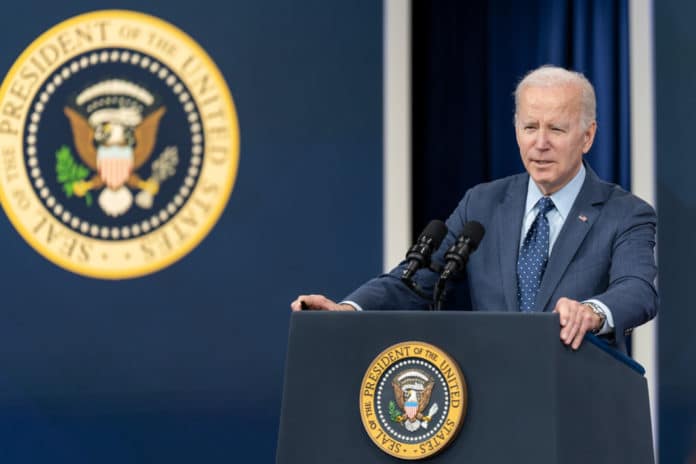(The Center Square) — Friday marks the one-year anniversary of Russia’s invasion of Ukraine, resulting in well over 100 billion in American taxpayer dollars being set aside to help the Eastern European country fend off its aggressor.
The U.S. Congress committed more than $113 billion in support for Ukraine across four major spending packages in 2022 alone, with the Committee for a Responsible Federal Budget saying more is likely to come.
“Of the $113 billion approved in 2022, about three-fifths ($67 billion) has been allocated toward defense needs and the remaining two-fifths ($46 billion) to nondefense concerns such as general Ukrainian government aid, economic support, and aid for refugee resettlement,” the CRFB said in a statement.
While these funds have already been set aside, the Congressional Budget Office estimates the money won’t be fully spent for years.
CBO estimates that three-quarters of the funding will be spent by the end of fiscal year 2026.
The Biden administration has handed weapons, not just cash, directly to Ukraine. For example, the Department of Defense in January announced about $3 billion worth of “security assistance,” with $225 million from the State Department for “Foreign Military Financing to contribute to the long-term capacity and modernization of Ukraine’s military.”
To accomplish this, DOD emptied out part of its weapons reserves for Ukraine.
“The Presidential Drawdown is the twenty-ninth such drawdown of equipment from DoD inventories for Ukraine that the Biden Administration has authorized since August 2021,” the DOD said.
Here are some of the military assets handed over in the January package, according to the DOD:
- 50 Bradley infantry fighting vehicles with 500 TOW anti-tank missiles and 250,000 rounds of 25mm ammunition;
- 100 M113 Armored Personnel Carriers;
- 55 Mine Resistant Ambush Protected Vehicles (MRAPs);
- 138 High Mobility Multipurpose Wheeled Vehicles (HMMWVs);
- 18 155mm self-propelled Howitzers and 18 ammunition support vehicles;
- 70,000 155mm artillery rounds;
- 500 precision-guided 155mm artillery rounds;
- 1,200 155mm rounds of Remote Anti-Armor Mine (RAAM) Systems;
- 36 105mm towed Howitzers and 95,000 105mm artillery rounds;
- 10,000 120mm mortar rounds;
- Additional ammunition for High Mobility Artillery Rocket Systems (HIMARS);
- RIM-7 missiles for air defense;
- 4,000 Zuni aircraft rockets;
- Approximately 2,000 anti-armor rockets;
- Sniper rifles, machine guns, and ammunition for grenade launchers and small arms;
- Claymore anti-personnel munitions;
- Night vision devices and optics;
- Spare parts and other field equipment.
But the U.S. isn’t alone in this support. According to the Kiel Institute for the World Economy, a German group tracking aid to Ukraine, European Union nations and groups have allocated nearly $60 billion to Ukraine.
“Overall, pledges of humanitarian assistance remained relatively constant over the course of the year, while the share of financial and military support pledges grew,” the group said.
Some experts say the funds help keep Russia at bay and send a message to discourage China from similar aggression.
“There is a clear strategic advantage for the United States in the defeat of Vladimir Putin’s barbaric war on Ukraine, both in terms of preventing future Russian aggression in Europe and deterring Chinese expansionism by demonstrating Western resolve and lethality,” Victoria Coates, an expert at the Heritage Foundation, told The Center Square.
Some Republicans have hesitated to support the large aid packages to Ukraine, saying that money could be better spent at home and raising questions about how the funds are being spent.
“We must halt Ukraine war funding,” said Rep. Andy Biggs, R-Ariz. “The Biden Administration is dragging us into major war rather than seeking diplomatic solutions.”
Coates criticized Biden for “politicizing” Ukraine funding.
“If President Biden continues to politicize support for Ukraine [and] refuses to work closely with conservatives on Capitol Hill, he risks undermining a year of concerted U.S. support for Ukraine, allowing Putin to regroup for potential future aggression, failing to exploit the opportunity to deter China, and repeating the experience of previous Presidents who have been unable to effectively make the case for war support to the American people,” she said. “All of which would be a waste of the $100 billion already committed to Ukraine.”
The invasion anniversary comes just after President Joe Biden made a surprise visit to Kyiv, Ukraine’s capital, to meet with Ukrainian President Volodymyr Zelenskyy.
As The Center Square previously reported, Biden held a joint press conference with Zelenskyy to “reaffirm our unwavering and unflagging commitment to Ukraine’s democracy, sovereignty, and territorial integrity.”
“That dark night one year ago the world was literally at the time bracing for the fall of Kyiv,” Biden said at a news conference with the Ukrainian leader.
It doesn’t appear that aid to Ukraine will dry up anytime soon.
“I will announce another delivery of critical equipment, including artillery ammunition, anti-armor systems, and air surveillance radars to help protect the Ukrainian people from aerial bombardments,” Biden said in a statement Monday morning. “And I will share that later this week, we will announce additional sanctions against elites and companies that are trying to evade or backfill Russia’s war machine.”


















